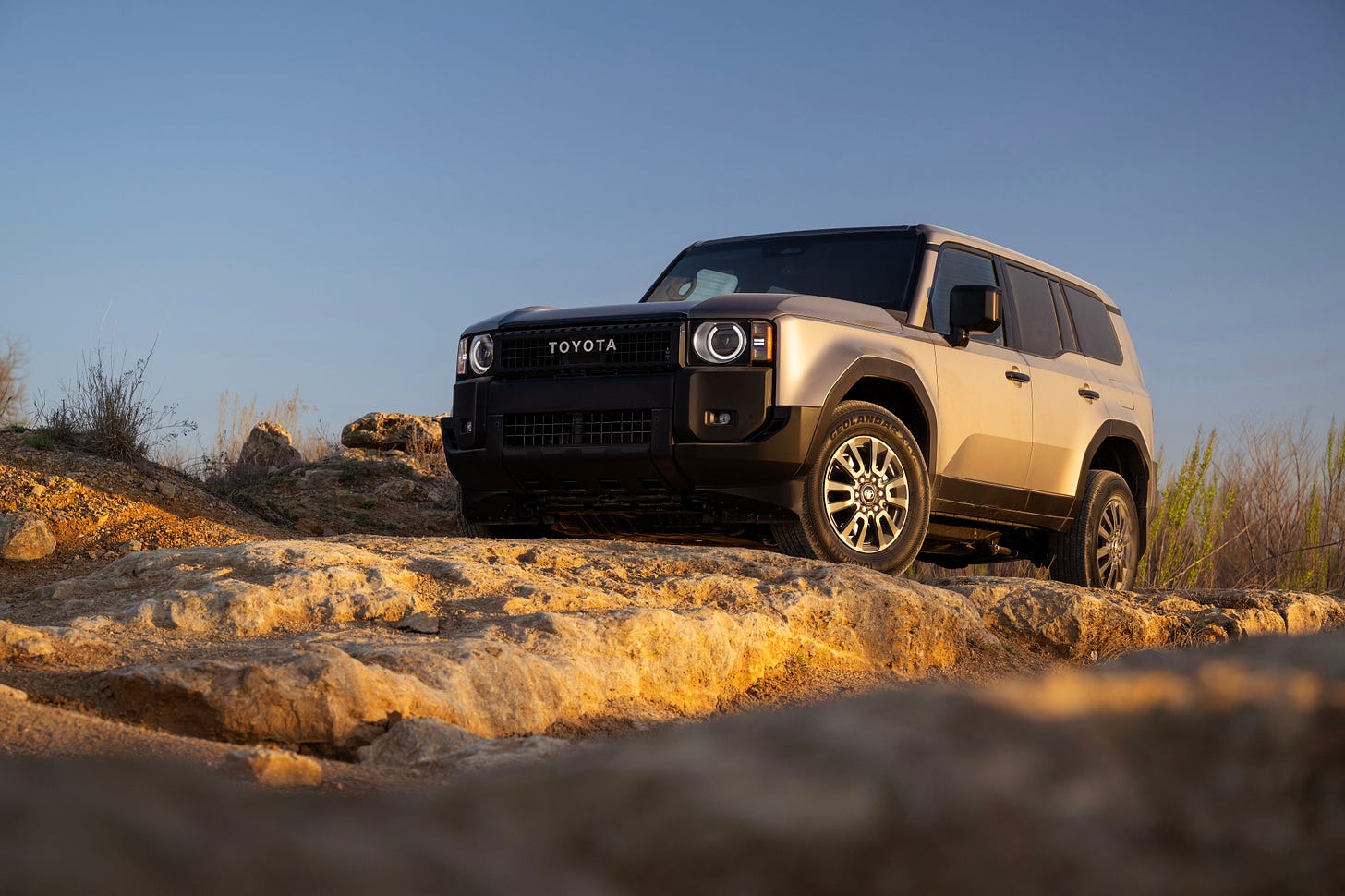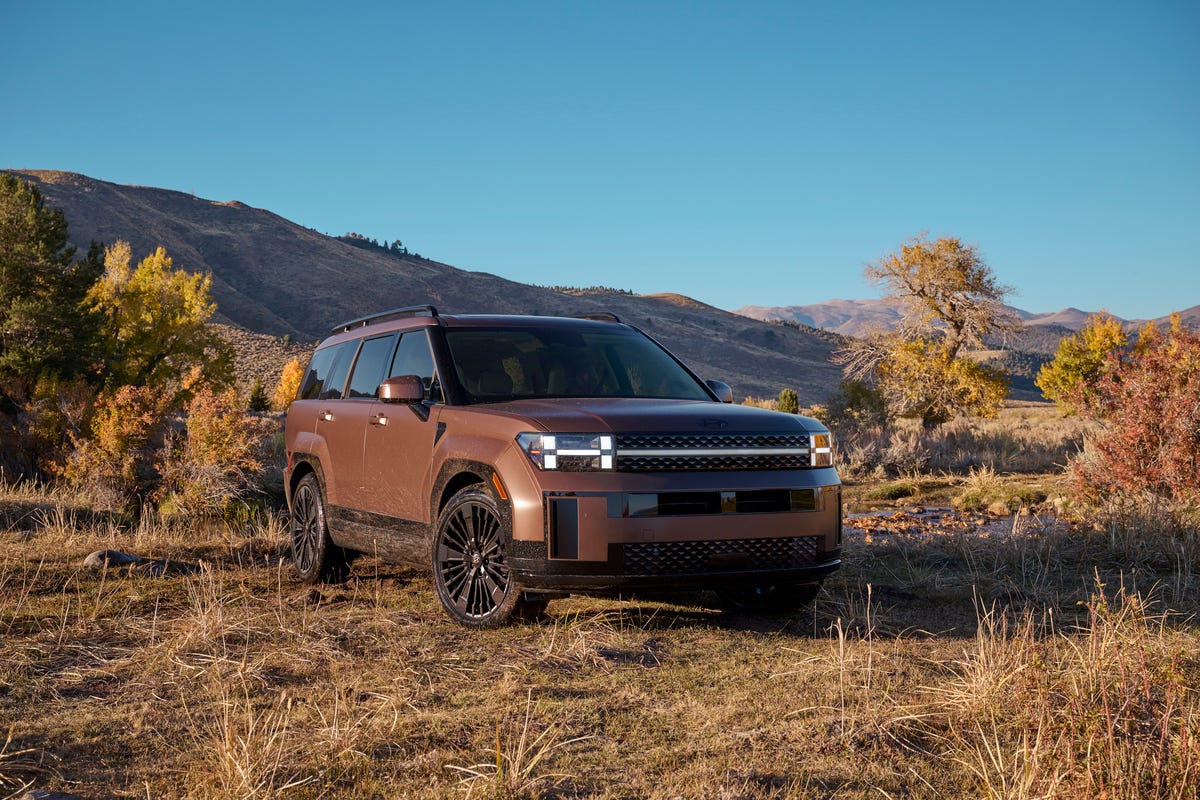Yes, Toyota flubbed the 2024 Land Cruiser re-launch — but not how you might think
Or, how the automaker could have had a huge, eco-friendly hit on its hands.
The return of Toyota’s legendary Land Cruiser to the U.S. market after a three-year absence1 had my favorite car YouTubers absolutely salivating back in the Spring of 2024. Same here. After all, it looked great, tapping into styling cues from the nameplate’s 75-year history at a moment when boxy is very much back in SUV design. Fast forward to December, and we’ve got heavy hitters like Doug Demuro and Jason Cammisa posting videos lambasting the 2024 Land Cruiser as a huge miss. What went wrong? Well, it’s a hybrid of reasons, but not the ones that Doug, Jason, and many enthusiasts would have you believe.
Yes, the big headline was that the Land Cruiser was coming back, but many eyebrows raised when Toyota announced that the U.S. version of the SUV would be powered solely by a 2.4 liter turbocharged 4-cylinder hybrid motor, albeit one generating 326 combined horsepower with 465 lb.-ft. of torque, while achieving 23 MPG.
For folks used to V-8 powered Land Cruisers since the late-’90s, this felt like a gut punch, even with the new powertrain boasting comparable output numbers. And when critics like Demuro and Cammisa got behind the wheel, the performance matched their fears:
“Never has 326 horsepower felt so much like 247 horsepower," said Doug. “You floor it and you're not really going all that fast.”
“It sounds like a dying calf... it's unpleasant even by four-banger standards,” lamented Jason. “If there's one word to describe how this engine sounds, it's ‘broken.’”
For people like me, the 23 MPG number seemed fine, especially when considering the absolutely laughable fuel economy of the iconic 80-series Cruisers (12 city/14 highway). Yet, given the 2021 Land Cruiser’s 17 MPG combined, the new model offers a relatively massive increase in efficiency, and, as I pointed out a few weeks ago, we should all be targeting at least an 8.4% increase in efficiency in our next car to move more quickly towards a greener future. But given all of the technology at our disposal, could Toyota — the king of hybrid technology, creator of the Prius – have done better? I think so.
So it was less powerful than the enthusiasts would like and less eco-friendly than the efficiency-minded folks would hope.
It also deviated from another core element of the Land Cruiser brand: luxury. By the release of the 80-series in the early ‘90s, the Land Cruiser evolved into a symbol of “stealth wealth,” as Cammisa put it in his video. While remaining extremely capable in all conditions, it was the most expensive vehicle in Toyota’s lineup, with a leather interior, creature comforts, and a cushy third row of seating. It was the SUV you bought instead of a Range Rover to appear a bit more humble (and also to avoid spending weeks in the service department). The 2024 edition, even in its top trims, did not inspire any lux feelings from reviewers.
In fact, it reminded folks of Toyota’s own 4Runner, another two-row, off-road-focused, legendary SUV whose pricing overlaps the Land Cruiser’s. Moreover, the 4Runner is set for a complete overhaul in 2025 that’ll bring two powertrain options (both 4-cylinders, though, including the hybrid), a myriad of rugged configurations, and stripped-down base model that will be far cheaper than any Land Cruiser. (And, Toyota also offers the Sequoia, a burlier three-row SUV that occupies the top-of-the-range space the old Land Cruiser once did, powered by a twin-turbo hybrid V-6 with comparable MPG to the Land Cruiser’s four-banger.)
When you look at 2024 sales figures, the all-new Land Cruiser sold just under 24,000 units, by far the biggest number ever for a Land Cruiser. But it’s deceiving: the Land Cruiser sales simply cannibalized sales of the 4Runner, which fell by about 27,000 units in 2024, and the 4Runner that was on sale was the 14 year-old version that is about to be replaced.
So, what would have been the sweet spot for a new Land Cruiser? More power? No, get a Sequoia. More rugged? 4Runner for you. But better efficiency? Stealth wealth? Now we’re talking. Toyota should have built something like the new Hyundai Santa Fe Hybrid and branded it the Land Cruiser.
That will undoubtedly sound blasphemous to most car people out there, and frankly I couldn’t quite believe it when I arrived at this conclusion. Here’s how…
Let’s talk about the Santa Fe Hybrid
Hyundai’s design team has shown a knack for understanding trends in the market and turning that insight into exciting sheet metal over the past few years, eschewing their blah, bubble-like models of a few years back in favor of truly timely, if not derivative, looks. The new Santa Fe relishes in the return to boxy SUV design, taking cues from Range Rover and Land Rover, in particular, to create a vehicle that feels of-the-moment yet also familiar.
The interior will blow away any outdated inklings that Hyundai is a “bargain brand” — especially when compared to what Toyota (or even Lexus) is doing these days. It also has all the thoughtful touches needed in a family hauler in 2025, from USB ports to wireless charge pads to cup holders galore. Oh, and did we mention the hybrid model gets 36 MPG combined?
It’s no surprise it’s ended up on many 2024 best-of lists, or mentioned countless times in Consumer Reports’ year-end podcast.
SUV efficiency is doable
I write about making driving greener, and it’s crazy to me that Toyota could not eke out more MPG from the Land Cruiser considering their reputation as hybrid innovators. They’ve also reduced the cargo capacity and eliminated a possible third row thanks to the way they packaged the hybrid batteries. It’s really baffling. Meanwhile, the Santa Fe offers a standard fold-away (but tiny) third row of seating and boasts that rather astonishing 36 MPG number; anecdotal reports I’ve seen from owners suggest city MPG routinely reaches into the forties. Remember how the Toyota’s 326 horsepower felt like 247 to Doug Demuro? The Hyundai has 231. And it weighs about 1,000 lbs less than the Toyota, so that 231 feels a bit more punchy.
Stealth wealth for days
The Santa Fe looks awesome on the outside (although its posterior styling leaves a bit to be desired) but it’s inside where it outshines the Land Cruiser by miles. From the Range Rover-esque steering wheel to the stylish center console to the elegant and effective infotainment system, it’s a really nice place to be. When your friends get into this vehicle, they won’t believe its starting price — which is $37,700 for the base trim, and maxes out, fully-loaded, in the low-$50s, which is still five grand less than the cheapest Land Cruiser.
But call it a “Land Cruiser”?! Heresy!
I think not. Here’s a stat that caught more than a few folks by surprise in the past week: Ford sold 7,000 or so more Mustang Mach E EVs in 2024 than gas-powered Mustang coupes. When Ford decided to apply its iconic pony logo and moniker to its first mass-market EV, purists gasped. But it was totally the right call. People love the Mustang brand, and the choice to connect that brand to a new era of electrified performance helped reorient existing fans to an emerging technology.
“All cars are drag costumes that drivers put on and take off in order to toy with perception, to undermine or underscore norms, or to communicate to the world, and to themselves, who they are and how they want to be seen,” writes Brett Berk, one of my favorite automotive scribes. “This is why vehicular purchases so often transcend the rational.” There’s no category of vehicle that’s more “drag” than a beefy SUV. As Berk’s piece points out, “98% of all SUV and crossover buyers drive off-road over rocks or in mud at most once per year, if ever, and 91% drive on dirt or gravel but one time a year or not at all,” per a study by automotive research firm Strategic Vision.
Maybe a Land Cruiser gets a bit more off-road usage than the average SUV, but the vast majority of its time is spent doing normal car things, while looking like a vehicle that can do rough and tumble things. It’s cosplay. It’s drag. A car like the Santa Fe embraces this mentality. Yes, it is available with all-wheel drive and even offers an optional tough-looking trim package, but it’s not conquering trails with the capability of a Land Cruiser, mainly because it doesn’t have to. And while it’s driving kids around and doing road trips, it’s not hauling around that rigid off-road equipment, leading to fewer visits to the pump for Santa Fe owners.
If we’re going to move towards greener driving behaviors, we need to embrace a more realistic approach to how we use vehicles, whether it’s considering low speed vehicles for short trips, like I talked about last week, or choosing vehicles that suit our actual needs vs. suiting our imagined ones. Our country has fallen in love with SUVs and crossovers for lots of reasons, and one of them is that they look cool — and that’s okay! Hyundai’s proven with the Santa Fe that you can have those tough SUV looks while maintaining sensible levels of MPG.
If Toyota kept the awesome, retro-inspired looks of the new Land Cruiser, stripped out the heavy, beefy off-road capability, leaned into a “stealth wealth” interior, and grabbed the 35 MPG powertrain from its own (albeit boring) Highlander crossover, you’d be selling them like — Santa Fes. That’s a drag show anyone can get behind.
To be crystal clear, the full-size Land Cruiser does come to America as the Lexus LX series.




